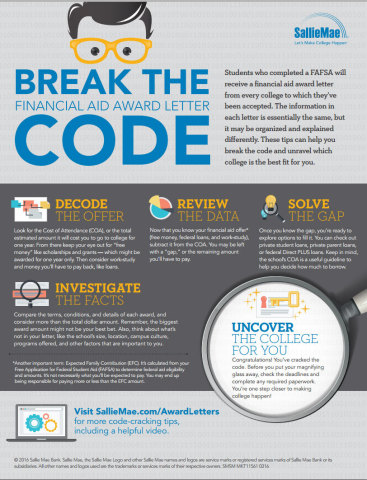NEWARK, Del.--(BUSINESS WIRE)--Award season may be over for the Hollywood crowd, but it’s just beginning for college-bound students: financial aid award letters have started to land in inboxes and mailboxes across the country. Considered among the most important documents families encounter during the preparing-for-college process, these letters reveal not only a school’s estimated cost, but also the types and amounts of financial assistance the school is offering.
Students who completed the Free Application for Federal Student Aid (FAFSA) will receive financial aid award letters from each higher education institution to which they’ve been accepted; the key is to understand and compare each offer before deciding where to attend. To help students and families analyze and interpret each offer, Sallie Mae — the nation’s saving, planning, and paying for college company — recommends the following tips:
- Decode the offer. The type of information in each financial aid award letter is essentially the same, but each school will likely use a different format. Look for the Cost of Attendance (COA), or the total estimate of what it will cost you to go to college for one year. Be clear on what part of the award is free money or “gift aid” like scholarships and grants, and what is “self-help aid” or money you’ll have to pay back, like federal student loans. In addition, the Expected Family Contribution (EFC), which is calculated from the FAFSA, will determine eligibility for federal student aid.
- Investigate the facts. When it comes to award letters, it’s critical to evaluate before you celebrate. Compare the terms and details of each award. A school’s award package could be considerable, but may consist mostly of student loans. Other awards may appear smaller, but include more scholarships and grants. Pay attention to award conditions and contingencies, and note which parts of the award are renewable and which are for one year only. Also, think about what’s not in the letter, like the school’s size, location, campus culture, programs offered, and other factors that are important to you.
- Review the data. Now that you know your financial aid offer (free money, federal loans, and work-study), subtract it from the COA. You may be left with a “gap,” or a remainder of what you’ll need to pay.
- Solve the gap. Once you know the gap, you’re ready to explore options to fill it. If what’s offered in financial aid, when combined with income and savings, doesn’t cover the full cost of college, a private education loan, like those offered by Sallie Mae, can be a responsible way to fill the gap. Sallie Mae will introduce its new Parent Loan next month to provide families with another option to meet any gap in college financing.
- Pay attention to deadlines. Complete and submit required documents promptly; missing a deadline could affect your award. National College Decision Day, the deadline for students to decide where they will attend college and to make their first deposit, is May 2, 2016.
“It’s important to take the time to study and compare each award letter carefully, because the biggest number may not automatically be your best bet,” said Martha Holler, senior vice president, Sallie Mae. “By comparing all the terms, conditions, and details in each letter, students and families can decode the offer that best fits their individual circumstances and make an informed decision.”
A new award letter is generated each year a student is enrolled, and the types and amounts of financial aid can change, so students should submit a FAFSA every year they are in school. For the 2017-18 academic year, students will be able to submit a FAFSA beginning Oct. 1, 2016, using their 2015 tax information.
For more tips on evaluating award letters, watch Sallie Mae’s “How to Read Your Financial Aid Award Letter” video, and visit SallieMae.com/awardletters.
Additional information about saving, planning, and paying for college is available at SallieMae.com.
Sallie Mae (NASDAQ: SLM) is the nation’s saving, planning, and paying for college company. Whether college is a long way off or just around the corner, Sallie Mae offers products that promote responsible personal finance, including private education loans, Upromise rewards, scholarship search, college financial planning tools, and online retail banking. Learn more at SallieMae.com. Commonly known as Sallie Mae, SLM Corporation and its subsidiaries are not sponsored by or agencies of the United States of America.




